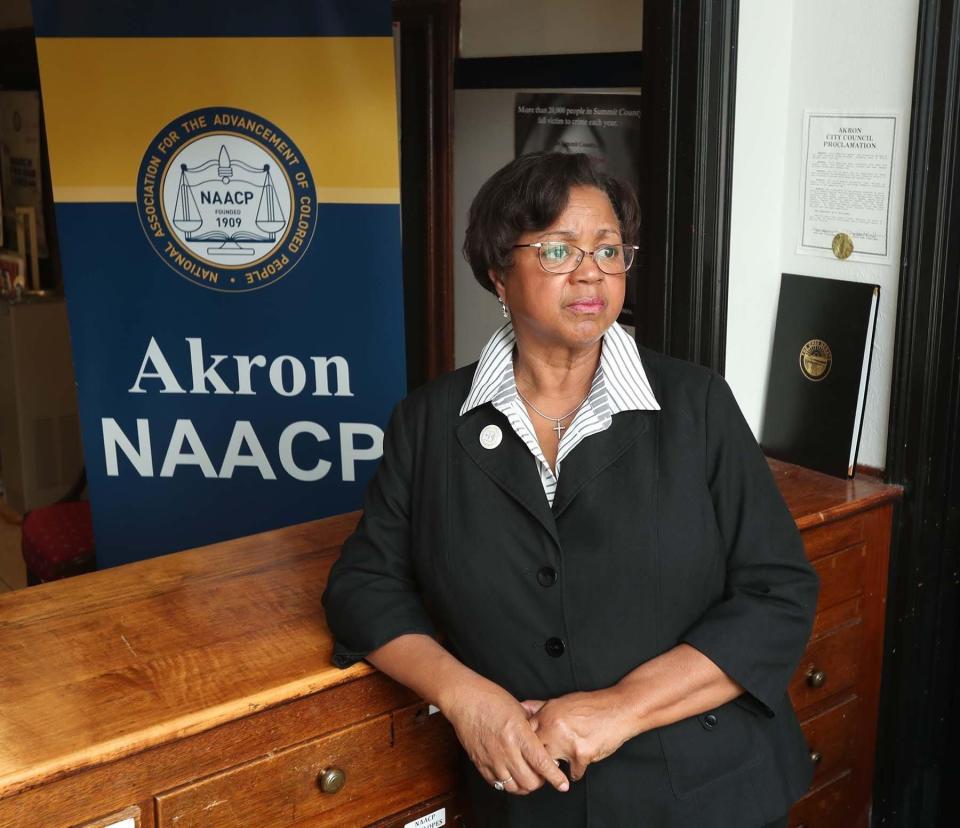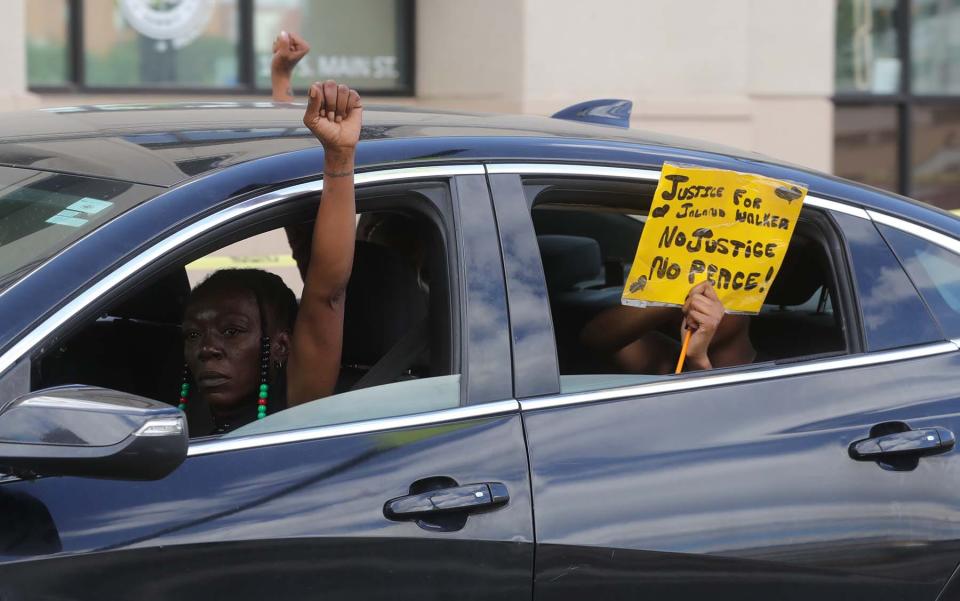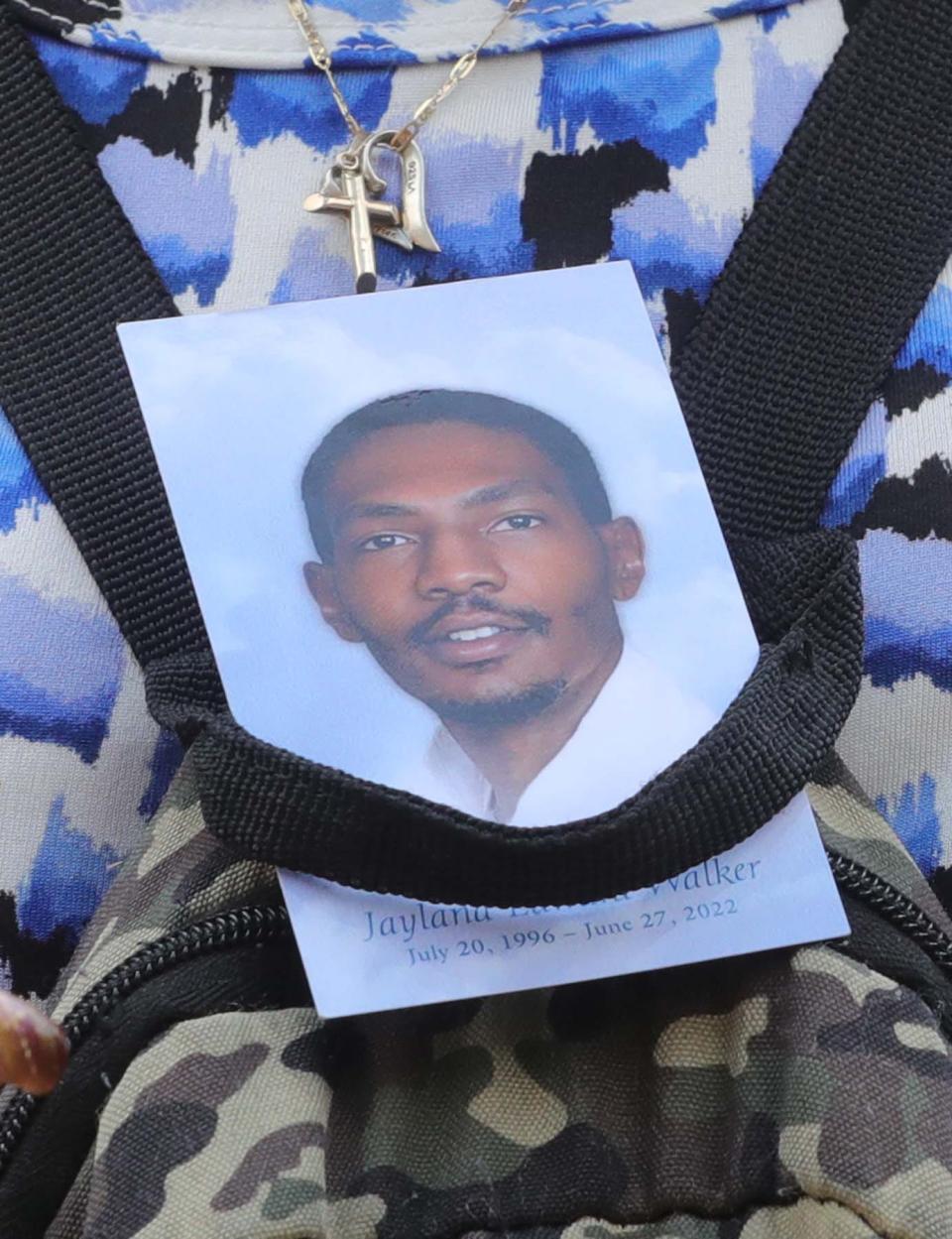What's next now that Akron voted big for a civilian police review board plan in Issue 10?
- Oops!Something went wrong.Please try again later.
After Akron voters resoundingly approved Issue 10, supporters of the citizen-conceived plan for added police oversight, the police union and the mayor have hinted at the cooperation and challenge ahead.
And the campaign that put the police reform on the ballot and then shoved it over the finish line could provide a roadmap for progressive candidates and issues to follow.
Akron NAACP President Judi Hill celebrated the victory election night with a statement that 62% approval should be received by city lawmakers as a resounding mandate to fully enact the new law.
Issue 10, motivated by the police shooting of Jayland Walker June 27, calls for the creation of a permanent police auditor position and civilian review board to review police action, including uses of force, citizen complaints and department policies. The plan initially proposed investigative powers and recommending officer discipline but whether the police union contract and existing laws would allow that is now up for interpretation in the Akron Law Department.
Issue 10 results:'Wow. Wow': 62% of Akron says yes to Issue 10, sending police oversight plan to council, mayor
“The people of Akron … are ready for systemic change,” Hill said moments after the final election results posted Tuesday night. “I am excited to work with such a progressive city because we know this is what we need in order to move forward. And now I think it behooves the city to really make this thing work right.
“The people have said this is what we want. It’s very clear. It’s no longer questionable.”

Mayor Dan Horrigan, whose staff tried to convince Hill and others to accept his own plan for a citizen oversight board, signaled his eagerness to oblige and put these tumultuous months behind him and his city.
“We may have chosen different paths to get here, but as long as we're unified in moving forward, I believe the formation of this board can and will make Akron stronger,” the mayor, who is not seeking reelection next year, said in an emailed statement.
The mayor's chief strategist and others have pointed out that new civilian review boards in other cities almost always need tweaked within the first year. With Issue 10 prescribing rules for a board etched into the city charter, getting it right on the first go-around is limited by what the petitioners called for from the get-go.
Akron mayor responds:After Akron's Issue 10 passes, Horrigan says he supports Citizens’ Police Oversight Board
The Fraternal Order of Police Akron Lodge No. 7 has questioned legal aspects of Issue 10 while giving the mayor’s plan kudos for at least requiring board members to undergo police training and go on ride-alongs with patrol.
In a statement, emailed Wednesday to media, the police union reiterated possible pitfalls should the city law director or council write the new board into the city’s constitution without consulting the FOP.
“Union leadership and our union attorneys are available to discuss and advise those charged with creating this additional layer of police oversight who may not be familiar with the collective bargaining agreement,” Akron FOP President Clay Cozart also said in the statement emailed to the media.
What happens next now that Issue 10 passed?
Definitive details on how the plan will be enacted, however, may not be clear until Akron Law Director Eve Belfance’s staff presents language on the voter-required charter change, which City Council must adopt no later than June 30.
For now, Horrigan appears to have abandoned his own police oversight board, which City Council passed 9-4 in an ordinance introduced shortly after political activists with Freedom BLOC and the Akron NAACP announced they had enough signatures for the ballot initiative.
Horrigan’s plan would have created an 11-member board. Issue 10 calls for nine members. The administration accepted 63 applications in October for the mayor's board. Four were disqualified as belonging to non-residents or candidates for office. (Issue 10 does not prohibit political candidates from serving on its board.)
The 59 otherwise qualifying applicants have been shelved, for now.
“We will keep those applications on file as we decide the course of action necessary to implement the will of the voters,” Horrigan said in his statement emailed early Wednesday morning.
Other than to say the “city doesn’t intend to have multiple citizen oversight boards,” Horrigan’s office said the mayor “won’t have further details on the board until the Law Department has been able to review and determine the next steps.”
Activists in Akron are paying close attention to these next steps while recruiting diverse members of the community to serve on the board and pursuing other police reforms that have been discussed since the murder of George Floyd by a Minneapolis police officer.
Those potential reforms include using community responders issues instead of police on non-violent calls, ending police chases for minor traffics stops and abolishing some crowd control tactics.
Jayland Walker shooting:Jayland Walker had 46 entrance wounds and died from 'devastating injuries,' examiner says
Some have called for civilian review of possible police misconduct, deadly use of force and citizen complaints since at least the 2000s. That demand renewed quickly after police fatally shot and killed Walker, a 25-year-old Black man.

More:What happened the last time Akron wanted a civilian review board for police oversight?
The Walker family, in a statement from their attorneys, celebrated the passage of Issue 10 as "Jayland's Law," which is a label leading advocates of the ballot issue said they had not heard of until now.

All but one Akron ward supported Issue 10
Issue 10 passed citywide 62% to 38%.
The campaign included canvassers who spent the summer registering voters in specific neighborhoods.
The police reform proposal received the strongest support from minority-majority areas of the city.
Wards 3, 4 and 5 (collectively Sherbondy Hill, Summit Lake, West Akron, East Akron and parts of South Akron, Middlebury and downtown) approved by measure by 83%, 80% and 77%, respectively.
Ward 3, followed by Ward 4 and then Ward 5, have the highest percent of voting age residents who are non-white, according to the city’s reporting of 2020 Census data.
Only Ward 6, which includes Ellet and the highest percentage of white voting-age residents, rejected Issue 10.
Ellet also had only two residents apply in October to serve on the mayor’s now moot civilian review board. Ward 8 had the highest number of applicants at 17, followed by Ward 7 with eight and Ward 2 with seven.
A roadmap for future progressives to follow?
The success of Issue 10 was as much a demographic reflection of Akron as it was the political strategy of its supporters. It's a success activists hope to emulate in future elections.
On the first day of early voting in early October, Freedom BLOC Executive Director Ray Greene told the Beacon Journal that his canvassers simultaneously circulated Issue 10 petitions and registered voters “mainly in Wards 3, 4 and 5,” with focus also on Wards 9 and 10.
As early voting began, Freedom BLOC canvassers checked voter rolls to ensure the processing of new voter registrations, then they knocked on doors to remind them that it was time to vote.
The plan is part of Greene’s long-term mission to build political clout in marginalized communities, establishing a bloc of voters capable of tipping local and national races in favor of progressive issues and candidates.
Mobilizing voters in these racially diverse wards, which also index higher than average on poverty rates, is harder because voters are more likely to move. They're more often required to cast provisional ballots because, as renters, they change addresses more frequently between elections without updating their voter registration status.
The result is nearly a third of voters in places like Ward 5 put on what the state calls "confirmation status," which is the first step before being purged from the voting rolls for inactivity or discrepancies with information maintained by the Bureau of Motor Vehicles or Social Security Administration.
“The biggest thing (preventing these residents from voting) is not only the relocation of people in poverty, but it's also the inability for either party to put anything on the ballot that makes people want to go vote,” Greene said a month ago. “That's why people are excited this year.”
It’s unclear whether the Issue 10 campaign, which is now retracing its steps to recruit diverse members to serve on the new board, can be used as a roadmap in future elections to drive turnout. Ward 4, for example, slipped from the second highest turnout in the city in 2018 midterms to the fourth highest this year. However, that may change after more absentee ballots postmarked before Election Day arrive next week.
Before the election, Greene speculated on whether a hometown Democrat like Emilia Sykes could ride the coattails of a get-out-the-vote effort behind Issue 10. A Beacon Journal analysis of the unofficial results finds a strong link between support for the police oversight and the congressional candidate, who won one of the tighter U.S. House races in the nation Tuesday.
But 4% of Akron voters left Issue 10 blank on their ballots compared to just 2.2% who voted in the Sykes race, meaning more Akronites were interested in the battle for Congress than police reform in their backyard.
However, support for Sykes and Issue 10 were intrinsically linked. Laid side by side in two corresponding lists, nearly every ward line up perfectly when ranked by support for Issue 10 or Sykes. Wards 1 and 8 — among of the most politically active portions of the city with median incomes and white populations indexing above the city average — had the widest gaps in support between the candidate and the local issue.
Reach reporter Doug Livingston at dlivingston@thebeaconjournal.com or 330-996-3792.
This article originally appeared on Akron Beacon Journal: Akron Issue 10: What's next after voters OK police review board


